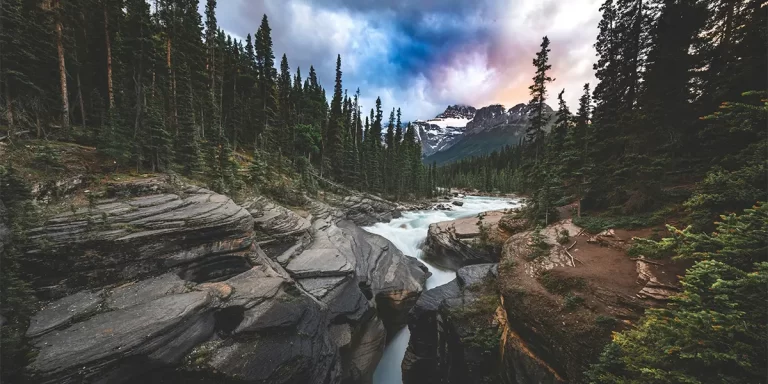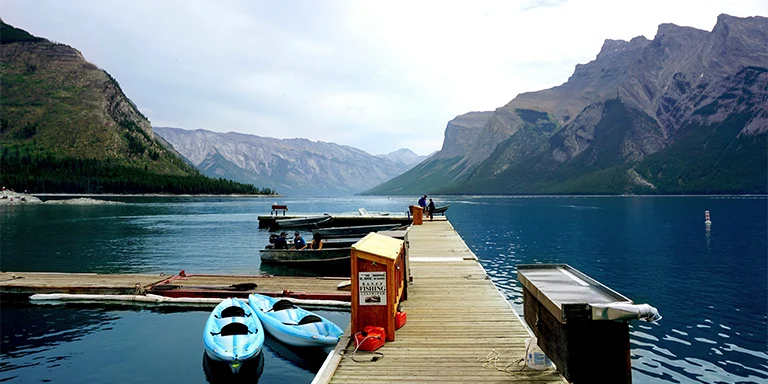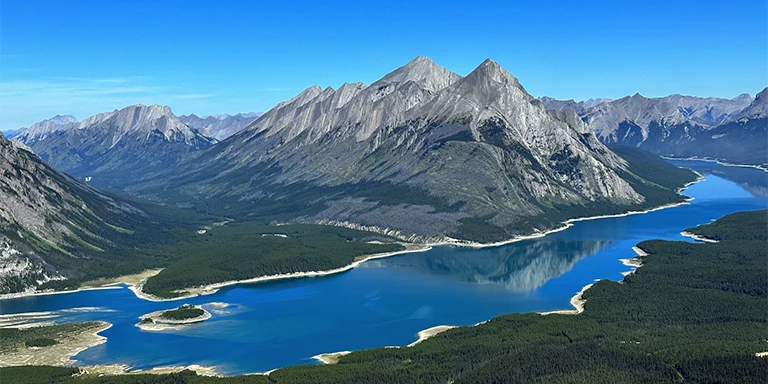

Backpacking in Alberta offers immense variety for outdoor enthusiasts, from the jagged Rocky Mountains of western Alberta to the rolling prairies and badlands of the east, including popular destinations like Banff and Jasper National Parks.
And that’s what this post is all about – backpacking in Alberta. We’ll provide tips to help you prepare for backpacking in this diverse province as well as showcase the best multi-day trails in Alberta.
From lush forests to turquoise lakes, Alberta’s landscapes provide spectacular backpacking opportunities. Whether you’re an experienced thru-hiker or new to backpacking in Alberta, the tips and trails highlighted in this guide will inspire your next adventure.
Let’s get started.
Explore the most scenic long trails in Alberta for incredible adventures:

Length: 27.9 mi / 44.9 km
Type: Point to point
Difficulty: Hard
Elevation Gain: 5118 ft / 1560 m
Location: Jasper National Park
Estimated Hiking Calorie Burn: 7950 calories
More Details: See on AllTrails
Hike this scenic 28-mile point-to-point trail from Maligne Lake to Maligne Canyon in Jasper National Park. A challenging route above treeline offering stunning vistas. Plan for a 2-3 day backpacking trip between May and October when accessible. As one of the park’s most popular trails, make campsite reservations early. Prepare for changeable mountain weather and bring rain gear, warm layers, bug spray and bear canisters. While demanding, the rewarding alpine scenery and chance to summit peaks make this a classic Canadian Rockies adventure.

Length: 25.7 mi / 41.4 km
Type: Point to point
Difficulty: Hard
Elevation Gain: 3520 ft / 1073 m
Location: Jasper National Park
Estimated Hiking Calorie Burn: 7450 calories
More Details: See on AllTrails
Experience awe-inspiring beauty backpacking the challenging 26-mile point-to-point Tonquin Valley trail in Jasper National Park. Traverse high alpine meadows to reach turquoise Amethyst Lake overlooked by soaring peaks. A quintessential multi-day Canadian Rockies adventure offering stunning scenery and solitude June-September.

Length: 36.3 mi / 58.4 km
Type: Out and back
Difficulty: Hard
Elevation Gain: 3631 ft / 1107 m
Location: Banff National Park
Estimated Hiking Calorie Burn: 9650 calories
More Details: See on AllTrails
Trek 36 scenic miles along the north shore of Lake Minnewanka on this challenging Banff National Park trail. A very popular route following the lakeshore with rewarding views. Plan for a multi-day backpacking trip between May and December. Arrive early to secure parking. Stop at picnic areas and campgrounds along the way. Hike up to Aylmer lookout for panoramic vistas. Bring proper gear as bear activity is common in summer. With towering peaks reflecting over crystal waters, Lake Minnewanka offers a quintessential Canadian Rockies experience.

Length: 26.1 mi / 42 km
Type: Loop
Difficulty: Moderate
Elevation Gain: 4770 ft / 1454 m
Location: Elbow-Sheep Wildland Provincial Park
Estimated Hiking Calorie Burn: 7850 calories
More Details: See on AllTrails
Hike the scenic 26-mile Elbow Loop in Kananaskis Country, popular for backpacking and mountain biking. Moderately challenging route with rewarding mountain views. Hike counter-clockwise for easier uphill. Stop at 3 well-equipped campgrounds for overnights. Take in views of peaks like Tombstone Mountain. Mix of gravel roads and single track provides a great intro to foothills backpacking.

Length: 31.8 mi / 51.2 km
Type: Loop
Difficulty: Hard
Elevation Gain: 4917 ft / 1499 m
Location: Banff National Park
Estimated Hiking Calorie Burn: 7900 calories
More Details: See on AllTrails
Hike the scenic 32-mile Mount Assiniboine loop trail near Canmore for stunning mountain vistas. A challenging route popular for backpacking and trail running May-September. Stop at equipped backcountry campgrounds like Lake Magog with reservations. Marvel at breathtaking beauty including Mount Assiniboine and Wonder Pass. Be prepared for changeable mountain weather and challenging terrain. Overall, a quintessential Canadian Rockies backpacking adventure.
Alberta, Canada, has a diverse climate with four distinct seasons:
Spring (April to June):
Summer (July to August):
Fall (September to October):
Winter (November to March):
Before grabbing your backpack and heading to the trailhead, take a look at some weather statistics for Alberta (Edmonton):
| Jan | Feb | Mar | Apr | May | Jun | Jul | Aug | Sep | Oct | Nov | Dec | |
|---|---|---|---|---|---|---|---|---|---|---|---|---|
| High °F | 22 | 27 | 37 | 53 | 64 | 70 | 74 | 72 | 64 | 50 | 32 | 23 |
| Low °F | 8 | 11 | 20 | 33 | 43 | 51 | 55 | 52 | 43 | 33 | 19 | 9 |
| Rain/Snow (D*) | 3 | 2 | 3 | 4 | 7 | 10 | 10 | 7 | 5 | 4 | 3 | 2 |
Not sure if Alberta is right for you?
Don’t forget to check out our backpacking guides for Washington and Montana.
Campers in Alberta’s parks and recreation areas are permitted to have campfires, but there are restrictions in place to prevent wildfires. Fires are only allowed in established fire pits or grates and must be fully extinguished with water before leaving a site. From March to June, a province-wide fire ban is in effect to protect public safety due to dry conditions. Provincial forest areas may have additional seasonal or total bans as fire risks rise.
Backpackers embarking on Alberta’s trails should remember key safety practices to enjoy a trouble-free nature experience. Always travel with a companion if possible and ensure someone knows your plans/route. Being properly equipped with navigation tools, first aid supplies, and weather-appropriate layers allows one to explore diverse natural settings. Signaling devices like a whistle, mirror or flare help summon aid in an emergency. Food, scented items and trash need protection from wildlife like securing in a bear-resistant container or high hanging when camping. Respecting posted advisories helps avoid risky situations, while basic outdoors knowledge can prevent injuries far from roads.
If you’re exploring the backcountry in Alberta, be ready to encounter various wild animals, including bears and moose. If you come across a predator, avoid direct eye contact, slowly back away, and use bear spray only if necessary. Keep a distance of at least 50 yards from all wildlife, and don’t approach, feed, or pet them. Make noise on trails to avoid surprising animals, check for signs like scat before camping, and if large herbivores charge defensively, run sideways, not straight on. Following safety guidelines, such as traveling in groups and heeding advisories, helps hikers peacefully coexist with Alberta’s natural inhabitants.
Banff and Jasper National Parks see the highest visitation numbers and offer incredible trail opportunities for outdoors enthusiasts. Within Banff, scenic trails like Lake Louise and Moraine Lake attract hordes of hikers daily. Jasper entices with majestic mountain routes like the Skyline Trek. Waterton Lakes sits in the southwest corner featuring magnificent alpine scenery and vibrant wildlife watching. Elk Island close to Edmonton provides a wildlife-rich experience, while Kootenay boasts glacial lakes and painted canyon lands. Whether it’s the stunning glimpses of towering peaks and turquoise waters in Banff or vast remoteness of Kootenay, Alberta’s national parks reward visitors with natural beauty and ecological diversity along their extensive trail networks.